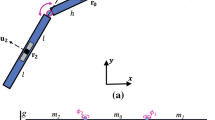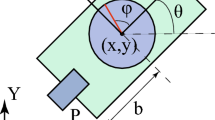Abstract
Multistability is an area of interest in robotics and locomotion because the ability to achieve multiple configurations or generate multiple gaits allows a single robotic or mechanical system to perform versatile tasks. This multistability is often achieved by adding multistable elements to the system. However, this work finds that two bodies pinned together with a linear rotational spring can exhibit multistable behavior with the introduction of a nonholonomic constraint. Multistable fixed points of the unforced and undamped system are found to correspond to multistable limit cycles with the introduction of damping and periodic forcing, some of which result in fast net turning. This finding has potential implications in understanding the sharp turns executed by biological swimmers and could be exploited to perform efficient turns in low degree of actuation robots.








Similar content being viewed by others
Availability of data and materials
Data sharing not applicable to this article as no datasets were generated or analyzed during the current study.
Code Availability Statement
Python code can be made available upon request.
References
Meng, L., Kang, R., Gan, D., Chen, G., Chen, L., Branson, D.T., Dai, J.S.: A mechanically intelligent crawling robot driven by shape memory alloy and compliant bistable mechanism. J. Mech. Robot. 12(6), 061005 (2020)
Tang, Y., Chi, Y., Sun, J., Huang, T.Z., Maghsoudi, O.H., Spence, A., Zhao, J., Su, H., Yin, J.: Leveraging elastic instabilities for amplified performance: Spine-inspired high-speed and high-force soft robots. Sci. Adv. 6(19), eaaz6912 (2020)
Zhang, H., Sun, J., Zhao, J.: Compliant bistable gripper for aerial perching and grasping. In 2019 International Conference on Robotics and Automation (ICRA), pages 1248–1253. IEEE, 2019
Wan, G., Liu, Y., Xu, Z., Jin, C., Dong, L., Han, X., Zhang, J.X.J., Chen, Z.: Tunable bistability of a clamped elastic beam. Extreme Mech. Lett. 34, 100603 (2020)
Cazzolli, A., Misseroni, D., Dal Corso, F.: Elastica catastrophe machine: theory, design and experiments, (2020)
Meng, Z., Chen, W., Mei, T., Lai, Y., Li, Y., Chen, C.Q.: Bistability-based foldable origami mechanical logic gates. Extreme Mech. Lett. 43, 101180 (2021)
Howell, L.L.: Compliant Mechanisms. Wiley, New York (2001)
Greigarn, T, Cavusoglu, MC: Pseudo-rigid-body model and kinematic analysis of mri-actuated catheters. In 2015 IEEE International Conference on Robotics and Automation, (2015)
Venkiteswaran, V.K., Su, H.J.: A three-spring pseudorigid-body model for soft joints with significant elongation effects. J. Mech. Robot. 8(6), 061001 (2016)
Katzschmann, R.K., Della Santina, C., Toshimitsu, Y., Bicchi, A., Rus, D.: Dynamic motion control of multi-segment soft robots using piecewise constant curvature matched with an augmented rigid body model. In 2019 2nd IEEE International Conference on Soft Robotics (RoboSoft), pages 454–461. IEEE, (2019)
Zhang, H., Zhu, B., Zhang, X.: Origami kaleidocycle-inspired symmetric multistable compliant mechanisms. J. Mech. Robot. 1(11), 011009 (2019)
Zhu, B., Zhang, X., Zhang, H., Liang, J., Zang, H., Li, H., Wang, R.: Design of compliant mechanisms using continuum topology optimization: a review. Mech. Mach. Theory 143, 103622 (2020)
Cazzolli, A., Dal Corso, F., Bigoni, D.: Flutter instability and ziegler destabilization paradox for elastic rods subject to non-holonomic constraints. J. Appl. Mech. 88(3), 031003 (2021)
Chaplygin, S.A.: On the theory of the motion of nonholonomic systems : the reducing multiplier theorem. Translated version in Regular and Chaotic Dynamics, (2008)
Borisov, A.V., Mamaev, I.S.: On the history of the development of the nonholonomic dynamics. Regul. Chaot. Dyn. 7(1), 43–47 (2002)
Bloch, A.M.: Nonholonomic Mechanics and Control. Springer Verlag, Berlin (2003)
Kelly, S.D., Fairchild, M.J., Hassing, P.M., Tallapragada, P.: Proportional heading control for planar navigation: The chaplygin beanie and fishlike robotic swimming. In Proceedings of the American Control Conference, (2012)
Fedonyuk, Vitaliy, Tallapragada, P.: Sinusoidal control and limit cycle analysis of the dissipative chaplygin sleigh. Nonlinear Dyn. 93(2), 1–12 (2018)
Fedonyuk, V., Tallapragada, P.: The dynamics of a chaplygin sleigh with an elastic internal rotor. Regul. Chaot. Dyn. 24(1), 114–126 (2019)
Fedonyuk, V., Tallapragada, P.: Chaotic dynamics of the Chaplygin sleigh with a passive internal rotor. Nonlinear Dyn. 95(1), 309–320 (2018)
Náprstek, J., Fischer, C.: Appell-gibbs approach in dynamics of non-holonomic systems. In: Reyhanoglu, Mahmut (ed.) Nonlinear Systems. IntechOpen, Rijeka (2018)
Náprstek, J., Fischer, C.: Non-holonomic Systems in View of Hamiltonian Principle. pages 3–25. 01 (2021)
Tallapragada, P.: A swimming robot with an internal rotor as a nonholonomic system. In: Proceedings of the American Control Conference (2015)
Tallapragada, P., Kelly, S.D.: Integrability of velocity constraints modeling vortex shedding in ideal fluids. J. Comput. Nonlinear Dyn. (2016)
Pollard, B., Fedonyuk, V., Tallapragada,P.: Swimming on limit cycles with nonholonomic constraints. Nonlinear Dyn. (2019)
Lee, J., Free, B., Santana, S., Paley, D.A.: State-feedback control of an internal rotor for propelling and steering a flexible fish-inspired underwater vehicle. In: 2019 American Control Conference (ACC), pages 2011–2016. IEEE (2019)
Free, B.A., Lee, J., Paley, D.A.: Bioinspired pursuit with a swimming robot using feedback control of an internal rotor. Bioinspir. Biomim. 15(3), 035005 (2020)
Fedonyuk, V., Tallapragada, P.: Path tracking for the dissipative chaplygin sleigh. In: 2020 American Control Conference (ACC) (2020)
Pars, L.A.: A Treatise on Analytical Dynamics. Ox Bow Press, Oxford (1965)
Bloch, A.M., Krishnaprasad, P.S., Marsden, J.E., Murray, R.M.: Nonholonomic mechanical systems with symmetry. Arch. Ration. Mech. Anal. 136, 21–99 (1996)
Bloch, A.M., Reyhanoglu, M., McClamroch, N.H.: Control and stabilization of nonholonomic dynamic systems. IEEE Trans. Autom. Control 37(11), 1746–1757 (1992)
Soltakhanov, S.K., Yushkov, M.P., Zegzhda, S.A.: Mechanics of Non-holonomic Systems. Springer, Berlin Heidelberg (2009)
Osborne, J.M., Zenkov, D.V.: Steering the chaplygin sleigh by a moving mass. In: Proceedings of the American Control Conference (2005)
Bizyaev, I.A., Borisov, A.V., Kuznetsov, S.P.: The chaplygin sleigh with friction moving due to periodic oscillations of an internal mass. Nonlinear Dyn. pages 1–16, 2019
Funding
This work was partially supported by the National Science Foundation Grant CMMI 2021612 and Office of Navy Research Grant N00014-20-S-B001.
Author information
Authors and Affiliations
Corresponding author
Ethics declarations
Conflict of interest
The authors declare that they have no conflict of interest.
Additional information
Publisher's Note
Springer Nature remains neutral with regard to jurisdictional claims in published maps and institutional affiliations.
Supplementary Information
Below is the link to the electronic supplementary material.
Supplementary file 1 (mp4 540 KB)
Appendix
Appendix
The mass matrix used in the Lagrangian and the equation of motion (3) is
Note that the mass matrix is used in the derivation before the rescaling, so the parameters here have not been rescaled. In the dynamical system (5) \(\varvec{{\mathscr {N}}} \dot{\varvec{\xi }} = {\varvec{g}}(\varvec{\xi }) + {\varvec{f}}(t)\), the inertia-like tensor
where
For the special case where \(c=0\), \(A=0\), fixed points can be defined for this system by solving \(\varvec{{\mathscr {N}}}^{-1} \, {\varvec{g}}={\varvec{0}}\). For nonsingular \(\varvec{{\mathscr {F}}}\), this simplifies to \({\varvec{g}}={\varvec{0}}\).
At a fixed point \(\dot{\varvec{\xi }}={\varvec{0}}\) and \({\dot{\delta }}=\omega _2=0\), requiring that any solution to 5 must result in \({\varvec{g}}=0\). Both \({\varvec{g}}_1=0\) and \({\varvec{g}}_2=0\) can be solved by setting
which gives a turning gait, or
which results in straight-line motion. The equation \({\varvec{g}}_4=0\) is satisfied if \(\omega _2=0\). The remaining equation \({\varvec{g}}_3=0\) can be satisfied for infinitely many adjacent \((u,\omega )\) pairs, resulting in non-isolated fixed points extending away from the constant energy manifold. Evaluating the dynamics reduced to the energy manifold results in isolated fixed points which can then be analyzed for stability. This reduction is performed by defining the system energy
which, rewritten in \(\varvec{\xi }\) coordinates, is
for
and
With energy rescaled, we now once again drop the \(^{\prime }\) superscripts and work only with the rescaled variables. The longitudinal velocity can be written as a function of \((\omega _1, \omega _2, \delta )\) and the energy. The reduced dynamical system is then obtained from the last three equations of (5) where \(u_x\) is substituted by a function of the other three state variables, \(u_x(\omega _1, \omega _2, \delta ; E)\). Suppose \({\varvec{H}}(\varvec{\xi }) = \varvec{{\mathscr {N}}}^{-1} {\varvec{h}}(\varvec{\xi }) \in {\mathbb {R}}^4\). Setting \({\varvec{H}}_r(\varvec{\xi }; E) = [{\varvec{H}}_2(\varvec{\xi }), {\varvec{H}}_3(\varvec{\xi }), {\varvec{H}}_4(\varvec{\xi })]^T\), which excludes the first component of \({\varvec{H}}(\varvec{\xi })\), the reduced dynamical system is
where \(\varvec{\xi }_r = (\omega _1, \omega _2, \delta )\). We then define the fixed points as a function of energy by substituting \(u_x(\omega _1,\omega _2,\delta ,E)\) into \({\varvec{g}}_3=0\), which gives an expression which can be solved for \(\omega _1^*\) as
for
Through straightforward manipulation of equation 23, we can find
Substituting \(b=b(\omega _1=\omega _1^*)\) and \(c=c(\omega _1=\omega _1^*)\) into 28 then yields \(u_x^*\).
Rights and permissions
About this article
Cite this article
Rodwell, C., Tallapragada, P. Induced and tunable multistability due to nonholonomic constraints. Nonlinear Dyn 108, 2115–2126 (2022). https://doi.org/10.1007/s11071-022-07336-3
Received:
Accepted:
Published:
Issue Date:
DOI: https://doi.org/10.1007/s11071-022-07336-3




